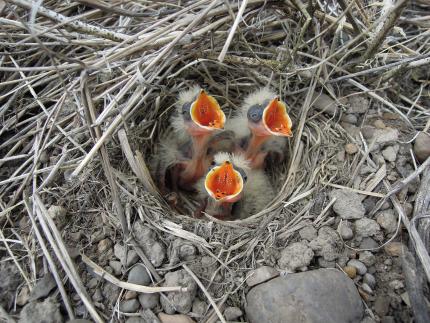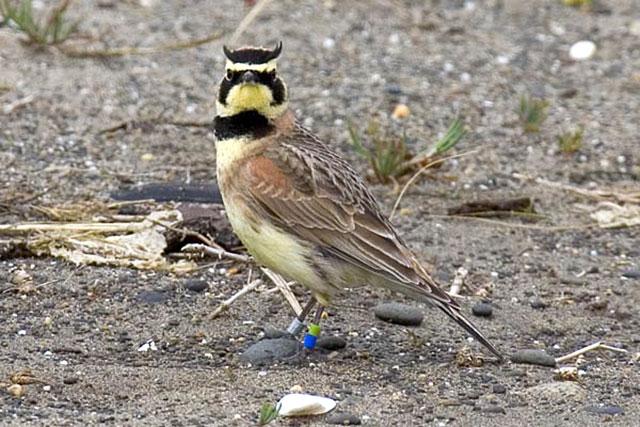Moderate
The streaked horned lark is a coastal subspecies only found in southwest Washington and western Oregon, with a range-wide population estimated at 1,170 to 1,610. It is an uncommon breeder on airport grasslands and remnant prairies, dredge spoil islands in the lower Columbia River, and beaches of western Washington and Oregon. Primary concerns are loss and degradation of habitat and human-related disturbance and mortality (example: mowing of grass) at breeding sites. is
Description and Range
Physical description
The streaked horned lark is a slender, long-winged passerine about 7 inches long. Adults are marked with a dark facial mask and breast band that contrasts with a pale face and throat. These features are especially clear and distinctive in adult males, which have a yellow throat. The “horns” for which the species is named are tiny, black feather tufts on the sides of the head in adult males. Adult females are similar to males, but duller, smaller, and lack horns.
Ecology and life history
In Washington, streaked horned larks are found on prairie and grassland south of Puget Sound, coastal beaches, dredge spoil islands and sparsely vegetated shoreline sites on the lower Columbia River. Streaked horned larks are also found on agricultural fields and drying seasonal wetlands in Oregon. Their habitat consists of large expanses of bare or sparsely vegetated land, including fields, prairies, upper beaches, airports, and similar areas with low/sparse grassy vegetation.

Streaked horned larks forage on the ground in bare fields or among short vegetation. They eat seeds and grass but feed their young insects, exclusively.
Streaked horned larks nest on the ground, where a clutch of three to five eggs is placed next to a tuft of vegetation or a small object. They may rear two to three broods per season. Nest building in southern Puget Sound generally begins in mid-April to early May, and concludes by mid-August.
Predation is responsible for most nest failures in Washington. Crows are the most important nest predator of streaked horned lark nests, which are also predated by western meadowlarks, some raptors and small mammals, and garter snakes.

Geographic range
The streaked horned lark was once more common and widespread, but has become increasingly rare with the decline in habitat, including south Puget Sound prairies. It is an uncommon breeder on airport grasslands and remnant prairies and beaches of western Washington and Oregon. It is considered extirpated in British Columbia. Evidence indicates that streaked horned larks in the Puget lowlands migrate south for the winter. Observations of banded birds throughout the winter suggests that some of these birds may overwinter in the Willamette Valley, Columbia River, and the Washington coast.
For maps of range-wide distribution and conservation status of the species, check out NatureServe Explorer and the International Union for Conservation of Nature Redlist.
Climate vulnerability
Sensitivity to climate change
Moderate
Streaked horned larks likely exhibit physiological sensitivity to warmer temperatures; they have been documented to alter behavior during warm periods (e.g., forage in shade, use wings to shade nests) and heat events have interrupted breeding season in other states. Streaked horned larks prefer open habitats with ample bare ground and very sparse, low stature vegetation. Populations in grassland areas may benefit from increasing fire frequencies that reduce vegetative cover and shrub/tree encroachment. Populations nesting on the banks of the Columbia River may be vulnerable to shifting flow regimes and flood peaks. Populations in beach/dune habitats along the Washington coast are vulnerable to changing sediment accretion and erosion patterns, which can change in response to hydrological shifts, current changes, changing precipitation patterns, and human management practices.
Exposure to climate change
Moderate
- Increased temperatures
- Altered hydrology
- Altered sediment accretion and erosion patterns (coastal)
Conservation
Conservation Threats and Actions Needed
- Fish and wildlife habitat loss or degradation
- Threat: Loss of prairie/grassland habitat.
- Action: Acquire or restore nesting habitat.
- Threat: Inbreeding/declining genetic health.
- Action: Translocation from Oregon for genetic augmentation.
- Resource information collection needs.
- Threat: Information needed on distribution, abundance, and status.
- Action: Occupancy surveys/counts at known and potential sites; compile, analyze data.
- Management decision needs
- Threat: Disturbance/mortalities on Columbia River sites from dredged material deposition.
- Action: Promote development of a management plan for dredged material at Columbia River sites.
- Overharvesting of biological resources
- Threat: Mortalities from collisions with aircraft on airfields.
- Action: Create/restore nesting habitat away from runways.
See the Climate vulnerability section for information about the threats posed by climate change to this species. In addition, toxic substances may present a hazard to streaked horned larks; these include zinc phosphide, used to control rodents, and seeds treated with pesticides to control pests and fungus.
Conservation Efforts

The subspecies is the focus of concerted conservation efforts with several key partners, including Joint Base Lewis-McChord, Ecostudies Institute, U.S. Army Corps of Engineers, the Federal Aviation
Administration, local airports, Oregon State University, U.S. Fish and Wildlife Service, American Bird Conservancy, Port of Portland, and The Evergreen State College. Conservation actions include protecting nests and fledglings at nesting areas, restoring habitat, genetic augmentation of an at-risk population, and experiments to attract larks to new locations.
Joint Base Lewis-McChord has collaborated with Center for Natural Lands Management, and currently with Ecostudies Institute, to monitor lark nests to help minimize impacts of mowing and training activities on nesting, and lark reproductive success improved in 2014 and 2015; no nests were lost to human-related causes in 2015. The Army Corps of Engineers recently committed to maintain and increase lark habitat at Columbia River dredged material deposition sites. These actions have improved the outlook for lark recovery.
Resources
References
Altman, B. 2011. Historical and current distribution and populations of bird species in prairie-oak habitats in the Pacific Northwest. Northwest Science 85:194-222.
Stinson, D. W. 2015. Periodic status review for the Streaked Horned Lark in Washington. Washington Department of Fish and Wildlife, Olympia, Washington.
WDFW publications
Status reports
- Washington State Periodic Status Review for the Streaked Horned Lark (2016)
- Washington State Status Report for the Mazama Pocket Gopher, Streaked Horned Lark, and Taylor's Checkerspot (2005)
